Windows Phone 8.1 Introduces Cortana (Update: Hands-on)
Microsoft shows off the new Siri and Google Now competitor in Windows Phone 8.1
Today Microsoft announced Windows Phone 8.1 at Build, the company's annual developer conference in San Francisco. Windows Phone 8.1 adds a voice-enabled personal digital assistant called Cortana, along with a host of user experience additions and personalization features.
The most significant part of this new version is Cortana, a personal assistant feature built to rival Apple's Siri and Google Now, and powered by Microsoft's search engine, Bing. Named after the AI character in Halo, Cortana is available as a Live Tile and is accessible via the regular Windows Phone search function.
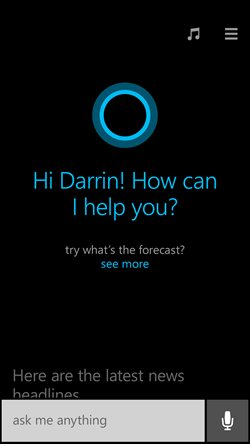
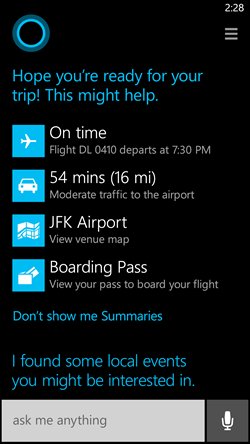
Like Google Now, Cortana follows and understands your behavior on the phone. It understands relationships, location, and many of your habits. Cortana can read the email on your phone (with permission) and extract relevant information; the example Microsoft Windows chief Joe Belfiore gave involved Cortana noticing flight information and asking if he wanted the flight's status tracked.
Cortana can also be extended to third-party apps via APIs, and there will be a few enabled applications from the get-go, including Skype, Facebook, Hulu and Twitter. For example, you can tell Cortana to call a particular Skype contact, or add a particular TV show to your Hulu queue, or check on a friend's Facebook status.
Belfiore said that the company actually talked to real-life assistants to find out how they do their job, and one of the discoveries was that most of them kept very specific information in a notebook, so Microsoft included such a notebook, and makes that transparent to the user. That information includes things like "Interests" and "Inner Circle." The latter refers to the people who matter most in your life and work, and Cortana purportedly understands those relationships and uses it to your advantage. For example, you can use Cortana's understanding of relationships for setting up rules to be interrupted when in the Quiet Hours feature of Windows Phone.
As you would expect, you can talk to Cortana, asking her to make appointments, find restaurants via services like Yelp, and other helpful information, and get back answers both by voice and by actual data-oriented results.
Cortana will launch in beta form, and while it had a few glitches during Microsoft's demonstrations, its errors didn't seem all that different than the ones you still get in Siri.
Get Tom's Hardware's best news and in-depth reviews, straight to your inbox.
Microsoft also added a couple of new Windows Phone hardware partners to its growing list (expanded during Mobile World Congress to include the likes of Huawei and ZTE for example), adding Micromax and Presigio. Yeah, we haven't heard of them either.
Microsoft added what it calls "Action Center" to Windows Phone 8.1, which is a quick way to access key settings features, like battery life and Bluetooth access, and also app notifications. Just like in Android, a swipe from the top of the screen gets you to the Action Center.
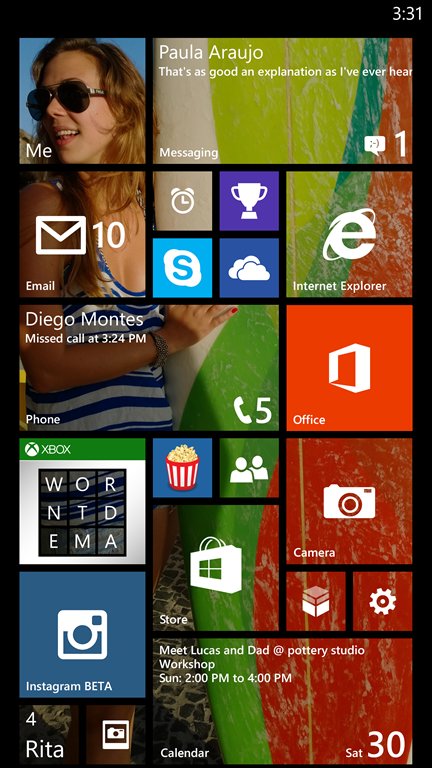

There were other UI enhancements, like a personalized lock screen (Microsoft has made APIs available so that developers can design some creative, interactive experiences). The Start screen's layout can also be customized more: you can change the density of tiles on the layout, and choose a background to put behind the tiles, for example. There are changes to the Windows Store experience, and a new Calendar app where you can swipe between days.
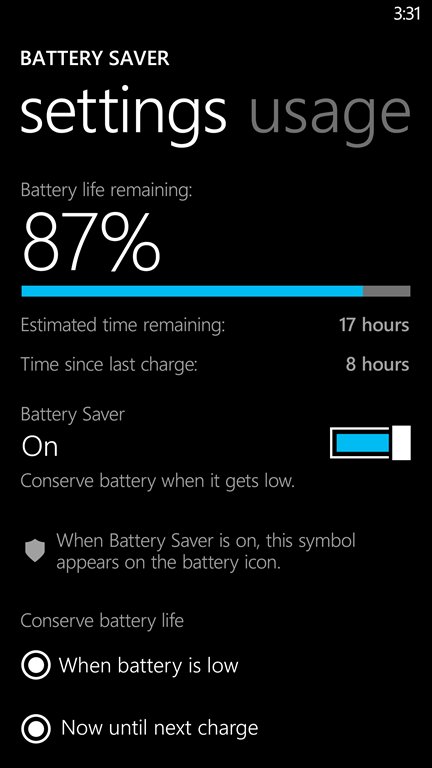
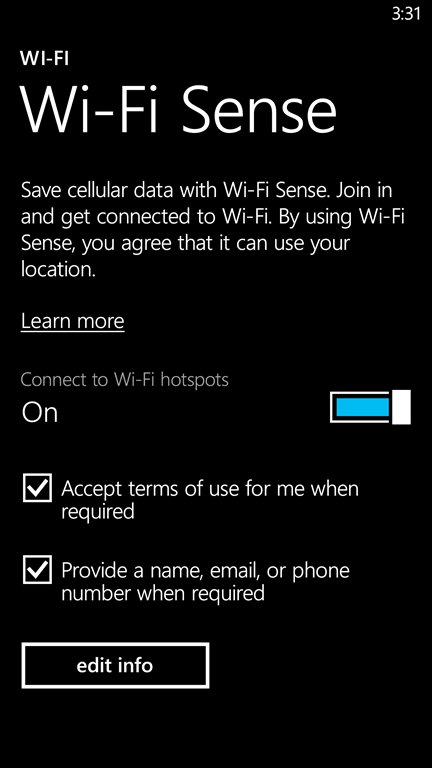
WiFi Sense learns about public WiFi hot spots, and can connect to them automatically when you're in range, and those that require you to accept terms of use, or provide other information can be fed all of that automaticaly as well.
There is also a new version of Skype in Windows Phone 8.1, and one of the more interesting aspects is that it is integrated into the Phone app, so you can switch a phone call to a Skype video call with the press of a button. Internet Explorer 11 will also be part of Windows Phone 8.1.
Microsoft also added a Swype-like function for its Word Flow keyboard.
Microsoft did not announce a timeframe for Windows Phone 8.1, only saying that it would be available on existing phones within the next few months. It will appear on new phones in late April or early May.
-
jacobdrj Video: 'Beta version of 8.1 on Lumia 520'So there is hope that I will see Windows Phone 8.1 on my Lumia 521... Joy...Reply -
JD88 Congratulations Microsoft. You have now caught up to where Android and iOS were 2 years ago. You've successfully copied most of the features of those platforms while innovating nothing on your own. Great job. Good to see Microsoft still doing what it does best.Reply -
TechieNewbie ReplyCongratulations Microsoft. You have now caught up to where Android and iOS were 2 years ago. You've successfully copied most of the features of those platforms while innovating nothing on your own. Great job. Good to see Microsoft still doing what it does best.
As an owner of a Windows phone all I have to say is, hooray! -
alextheblue ReplyCongratulations Microsoft. You have now caught up to where Android and iOS were 2 years ago. You've successfully copied most of the features of those platforms while innovating nothing on your own. Great job. Good to see Microsoft still doing what it does best.
You act like all these features debuted on Android or iOS. Silly troll, where were you when they were ripping off Palm or WinCE? I used Swype on a WinMo device long before anyone with an Android phone showed off the "innovation". -
JD88 Reply13018564 said:Congratulations Microsoft. You have now caught up to where Android and iOS were 2 years ago. You've successfully copied most of the features of those platforms while innovating nothing on your own. Great job. Good to see Microsoft still doing what it does best.
You act like all these features debuted on Android or iOS. Silly troll, where were you when they were ripping off Palm or WinCE? I used Swype on a WinMo device long before anyone with an Android phone showed off the "innovation".
So what about all the other features they ripped from Google? How about how Cortana is essentially a Google Now clone. Or how about pull down notifications? Name one thing Windows Phone has innovated... It really is sad that a company can exist for so long thanks to monopoly power when it offers no innovation whatsoever and is frequently 2 years behind the competition in almost every aspect. I hear they are handing out those licenses for free now lol. -
vaughn2k Reply
As long as everyone ismaking business, it doesn't matter, whether it is copied or not. These guys wanna make money, and also make competition. I don't care at all. All I care is a money well spent. ;)
So what about all the other features they ripped from Google? How about how Cortana is essentially a Google Now clone. Or how about pull down notifications? Name one thing Windows Phone has innovated... It really is sad that a company can exist for so long thanks to monopoly power when it offers no innovation whatsoever and is frequently 2 years behind the competition in almost every aspect. I hear they are handing out those licenses for free now lol.13018564 said:Congratulations Microsoft. You have now caught up to where Android and iOS were 2 years ago. You've successfully copied most of the features of those platforms while innovating nothing on your own. Great job. Good to see Microsoft still doing what it does best.
You act like all these features debuted on Android or iOS. Silly troll, where were you when they were ripping off Palm or WinCE? I used Swype on a WinMo device long before anyone with an Android phone showed off the "innovation". -
Aoyagi So much for the "big" update. I've had a WP8 device for over 10 months and I've actively used it for most of that period. There are many things I consider a downside of varying importance (some of which are a result of the extremely closed design) and the only thing they fix is a VPN client and that's to unknown extent. WP8 is a toy more than anything.Reply -
nikolajj ReplyCongratulations Microsoft. You have now caught up to where Android and iOS were 2 years ago. You've successfully copied most of the features of those platforms while innovating nothing on your own. Great job. Good to see Microsoft still doing what it does best.
Is does not have to be a new thing to be better! Pretty much nothing you know about is original. The trick is to do it better, and this is where MS shines. They might not be first out, but they offer refined, polished products. Personaly, I prefer 'done right' over 'done first'.ps1.: I have not tried WP8.1, but own a WP8 phone, and its amazing!ps2.: Microsoft WAS the first to make a tablet, not your "Innovative" Apple. But no one cared back then (bad timing on MS's part), and it was not the first tablet like thing back then either.
